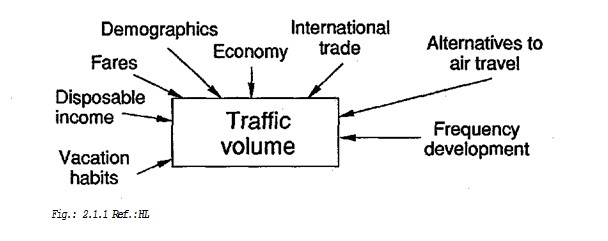Travel demand contributes 80% of passenger traffic growth and is the most important subject to look at for prognoses. Another 20% is stimulated by extra frequencies being available.
Air travel demand is in one way or an other always related to the economic environment.
Economic trends are reflected by the Gross National Product (GNP) of a given world area. According to the different market characteristics growth is specially reflected in the aircraft business in terms of:

Fig.: 2.1.1 Ref.:HL
Changing vacation habits are leading to more shorter excursions that will be made in addition to annual holidays. As an example are travel motivations studied in 1990 and 1991 by Airbus Industie for European and North American scheduled services.
| European traveler | North American traveler | |
| Purpose of the trip | ||
| Mainly business | 46.9% | 24.5% |
| Mainly vacation | 41.1% | 63.5% |
| Other reasons | 11.1% | 10.6% |
| No answer | 0.9% | 1.4% |
| 100% | 100% | |
| Fare class | ||
| First class | 2.1% | 4.3% |
| Business class | 29.1% | 8.9% |
| Economy+discount | 63.9% | 80.8% |
| Do not know | 4.9% | 6.0% |
| 100% | 100% |
The result is that 41.1% in Europe and as many as 63.5% of passengers in North America made their trip for reasons of pleasure or vacation.
Another aspect is that, especially in North America, most business passengers took advantage of economy and discount fares.
The forecast is that the share of business travel will globally decrease to some 20% of the total travel volume.
Disposable income is, after having satisfied the needs for basic consumer products, more and more used for leisure travel, which often includes air travel.
Real fares are decreasing with a continuing trend in the order of 0.5% p.a. sustained by liberalisation, increased competition between established and newcomer airlines and cost-cutting measures within the airline industry.
The demographic trend is that the world-wide population, will generally increase by around 1% p.a. in the industrialised world and 2.5.% p.a. in developing countries. People of all age groups have gained air travel experience, increasing their willingness to continue flying.
Economic growth in terms of real increase in GDP is in the order of 3.3% annually, following a cyclical pattern.
International trade influences primarily long-haul passenger and cargo markets and the creation of direct flights.
Alternatives to air travel include international teleconferencing facilities that could partly replace the need for corporate travel. High-speed trains will on short-haul distances complement air transport in selected markets, protecting the environment and allowing airports to allocate slots for medium and long-haul air services without enlarging the airport infrastructure.
Frequency development and traffic volume influence each other. For instance, offering more (non-stop) flights or opening up new routes will make air travel more attractive. On the other hand, the airlines’ inability to increase their departures out of certain airports, coupled with growing delay problems, may show a negative impact on traffic growth potential.
